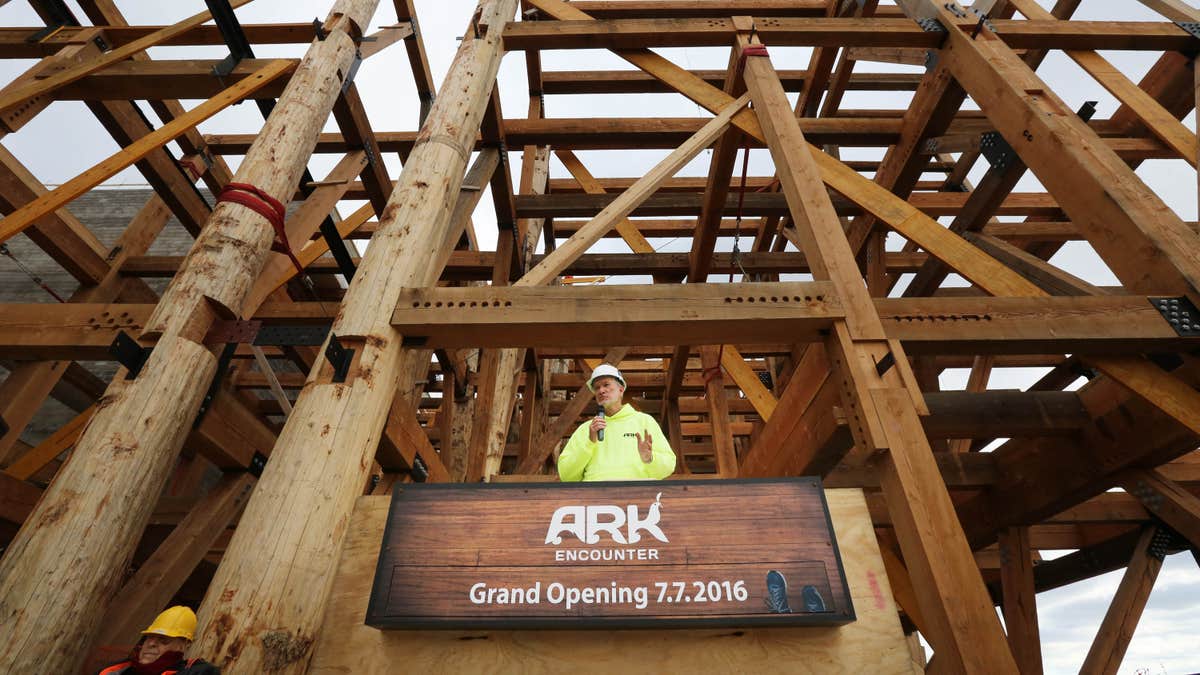
Nov. 12, 2015: Ken Ham, co-founder and president of Answers in Genesis, the group that is building Ark Encounter, addresses the media during a press conference in Williamstown, Ky. (AP)
I’m often asked why we at Answers in Genesis are building a life-size Noah’s Ark as a family-friendly entertainment and educational experience called Ark Encounter, set to open next July in northern Kentucky. For me, it is equal parts passion and purpose.
First, it is something of a legacy project. You see, my parents taught me to trust the Bible from its very first chapters, and their influence helped lead me to start Bible-upholding outreaches like the popular Creation Museum and now the Ark.
The purpose of the Ark will be to share God’s love and mercy. I hope to see millions of individuals visit the Ark Encounter and grasp the reality of the global Flood as a reminder that God judges sin, but also as a reminder of His plan of salvation for the righteous man Noah and his family, and for us through our modern-day Ark of salvation, Jesus Christ.
Some of the other questions I’m often asked (and our Ark re-creation will answer them through its numerous exhibits inside) have to do with how Noah could have accomplished such a feat, and how the Ark could have held and sustained all of the animals aboard.
Despite the many explorations and suggestions that the Ark has been discovered, the final resting place of Noah’s Ark remains a mystery.
The size of the Ark made it roomy enough for all on board, measuring 510 feet long, 85 feet high and 51 feet high. The Bible uses a cubit measure, and we use the Hebrew long cubit measuring 20.4 inches. One of the most-asked questions is how Noah could fit all the animals on board the Ark. He only had to take representatives of the land animal kinds. Now with the word “kind” in the Bible, creation scientists believe it is at the “Family” level of classification. Research indicates 1,500 kinds at the most were needed on the Ark (two of each kind, and seven of some), so there was plenty of room for the few thousand animals needed.
The average size of a land animal is not that large, and for the few kinds that grew to large sizes, it makes sense that young adults of those types were probably chosen to be on the Ark.
Others wonder how Noah could have built the Ark, managed to collect all the animals and care for them on board for about a year. Noah and his sons may have hired laborers to help them. Today, one or two men can erect a large house in just 12 weeks. How much more could 3 or 4 men do in a few years? Once the Ark was built, the animals actually arrived themselves; the Bible says that God brought them to Noah. Considering that the world was probably only one continent at the time, the animal migrations may not have been as difficult as it sounds.
Regarding people and animals surviving on the Ark for a year, I point out that it’s possible that many of the animals could have spent some of the time in a form of hibernation, lulled by the darkness and the rocking of the ship. Most animals react to natural disasters in ways that were designed to help them survive, so they may have similarly responded to the Flood. And even if they didn’t hibernate, we can imagine all kinds of ingenious systems and devices on board the ark to allow for feeding, watering, and waste removal for all of the animals. There is no reason not to accept a surprising degree of high technology in ancient times. Civilizations since the Flood exhibited incredible human ingenuity, to the extent that even with today’s technology we can’t figure out how they accomplished certain feats, like lifting large numbers of enormous stone blocks into place (e.g., the Pyramids). We don’t know what level of technology Noah had, but it may have been more than we could imagine today.
The Ark itself could have survived the wind and waves due to its proportions. Our researchers have shown that the stability and strength of the Ark are similar to modern cargo ships. Noah’s Ark could also have handled waves as high as 100 feet.
Finally, despite the many explorations and suggestions that the Ark has been discovered, the final resting place of Noah’s Ark remains a mystery. Scripture says Noah’s Ark rested on the mountains of Ararat, which could refer to several areas in modern-day Turkey or neighboring countries. Considering it landed about 4,300 years ago, the Ark could easily have deteriorated, been destroyed (e.g., by lava flows), or been used as lumber by Noah and his descendants.
What extra-biblical evidence do we have for a global Flood? Our staff geologist Dr. Andrew Snelling says the geological evidence can be seen all over the earth, from sea beds to mountaintops. Wherever you go, the physical features of the earth’s terrain clearly indicate a catastrophic past, from canyons and craters to coral beds and caverns. Some layers of fossil-bearing strata extend across continents, revealing the effects of a huge catastrophe.
In addition, the earth’s crust has massive amounts of layered sedimentary rock, sometimes miles deep! These layers of sand, soil and material – mostly laid down by water – were once soft like mud, but they are now hard stone. Encased in these sedimentary layers are billions of dead things (fossils) buried very quickly.
Yes, the evidence for Noah’s global Flood is everywhere and confirms the biblical account. We provide answers such as these and many others at our website, and we hope the opening of the Ark Encounter next July will inspire millions to explore this part of biblical history and come to understand it as a picture of God’s love and plan of salvation for mankind.
